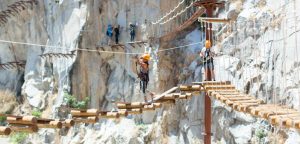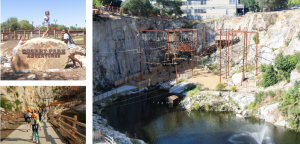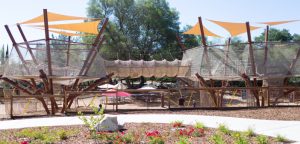In describing Quarry Park Adventures, an adventure park in an abandoned quarry in Rocklin, Calif., the old cliché is inescapable: this is a park that exists, literally, between a rock and a hard place. Built in a quarry, it is a unique setting that presents both challenges and opportunities.
From Liability to Asset
First, a little background. Located in northern California just east of Sacramento, Rocklin is a city of roughly 60,000 residents that has a 140-year history of granite mining, from the 1860s to the early 2000s. Granite from the Quarry Park quarry was used to build the state capitol in Sacramento.
When the mining ended just a few decades ago, a variety of empty quarries were left behind. Quarry Park’s quarry was right in the heart of the city, within a public park called, appropriately, Quarry Park.
City leaders put their heads together to try to figure out a way to make constructive use of a 70-foot-deep, five-acre hole in the ground. This was part of a larger scheme to turn Quarry Park—the public park—into a more active and productive municipal asset, to complement a 1,100-seat amphitheater and other activities and services.
After consulting with Sacramento-based park developer Legacy Family Entertainment (LFE), the city council determined, in 2017, that an adventure park would be an unusual, yet exciting, way to make use of the quarry while also making it an economic engine. Adventure park developer Bonsai Design won the bidding process to become the builder, successfully filing a request for proposal (RFP), as required by law for a municipal project.

The quarry’s rock walls created the perfect environment for a via ferrata, while a trekking course provides an alternate activity.
Crafting the Park
Bonsai had extensive experience in building in forest and mountain environments, but building in a quarry was a whole new ball of wax. When construction began in early 2018, the main challenge was building on a surface that was, obviously, rock hard. “It was very labor-intensive,” says Dylan Burt, who, with his wife Abby, currently operates the park under the aegis of their company, Applied Adventure Consulting.
Because the quarry was treeless, Bonsai erected three-story metal posts to support elevated activities within the quarry. It took hours to bore the posts’ foundations into the hard stone. More boring was necessary to install a via ferrata around the quarry walls, as well as handholds for a climbing wall. The hard surfaces also presented challenges in installing utilities (electric, water) that might need underground conduits.
Multiple adventures. Within the quarry itself, Bonsai assembled a total of six activities: a three-line zip-line (allowing riders to race one another); a 60-element aerial adventure course; a via ferrata; a climbing wall; a 40-foot free fall; and a 60-foot rappel. While many parks rely on woodsy beauty as a major theme, Bonsai chose activities—i.e., the via ferrata, the rappel, and the climbing wall—that took advantage of Quarry Park’s rocky assets. In addition, at the city’s urging, Bonsai chose to highlight the historical aspects of the quarry, incorporating, for example, some of the machinery once used in granite mining.
Construction of the park was completed in late 2018. After the park opened, though, the relationship between the city of Rocklin and LFE soured. The Burts, who had worked with Bonsai in the past, took over management in the spring of 2019. Their combined experience and operational track record made them an attractive choice to run the show. They signed a lease agreement with the city, in which they would pay it a percentage of the park’s annual gross revenues.
Multiple challenges. While the uniqueness of the quarry setting had undeniable marketing appeal—there are few places in the country where visitors can have fun in this kind of environment—the setting also came with unique operational challenges.
For starters, access isn’t easy. A steep pathway provides entry and exit to the park, and is not ADA-certified. It can be difficult for some people, smaller kids in particular, to negotiate. Until recently, entry into the quarry was limited to kids 70 pounds and larger, although the Burts determined recently that they could reduce that to 45 pounds (a change Dylan expects to produce “a significant impact” on park visitation numbers).
Still, the steep path isn’t for everyone, which is the main reason that two additional activities have been made available at the surface level. These include Kidz Kove, a netted, small-scale, low-elevation collection of zip lines, balance beams, and climbing challenges (for ages 3 through 13), and paddle boating on a small lake.
In addition, given that the quarry is essentially a big hole in the ground, storm water drainage can be an issue. While there is a retaining pond at the bottom of the quarry, it has its limits; the lack of porosity in the quarry’s granite subsurface makes pond drainage extremely slow. After last year’s “atmospheric river” events in California that made national news, the quarry was overwhelmed by the deluge. Closure of the park was necessary, and the only way to remove the excess rainwater was to pump it out before reopening was possible. Obviously, the atmospheric river was an unusual weather phenomenon, but even lesser rainfalls can result in drainage issues.

Above and right: Bonsai and the town of Rocklin gave the park a grand entrance. The path, above, provides the primary access.
Public-Private Partnership
In some other respects, however, the Burts have several operational advantages at Quarry Park.
Municipal benefits. For starters, they have no long-term-debt obligations, since the construction of the park was paid for by the city of Rocklin, and the city owns the land.
And while the city owns the park, the city government is “fairly hands-off,” says Dylan, when it comes to park management. In other words, there is little meddling from city hall when small tweaks are needed here and there. Relations between the park operators and the city are primarily coordinated through the director of Parks and Recreation.
The flip side to that arrangement is that more substantial changes, such as adding new activities, face the prospect of getting bogged down in the machinery of government. Major improvements or additions must be reviewed and approved through the city council. “It takes time to get things done,” says Dylan. “You go talk to the city and then wait a couple of years.”
Labor pool. Although Abby says that staffing was an initial challenge after the Burts took over management from LFE (taking a year or so to “balance out,” as she puts it), being in an urban area means a sizable population base from which to draw. The park’s staff of 30 in the shoulder seasons grows to 80 during full-operation summer months.
In addition, many of the executive tasks, such as accounting, are managed at Applied Adventure’s home base in Colorado, with that cost shared by the other parks under the Burts’ management. That creates efficiency at the executive level and allows the park staff to focus almost exclusively on day-to-day operations.

The Kidz Kove, on the site above the quarry, offers easy access to aerial fun for children ages 3 to 13.
Municipal responsibilities. Operating a municipal facility comes with obligations not necessarily associated with a private park. The Burts recognize that, from the city’s perspective, Quarry Park is a public asset, paid for with taxpayers’ money, and should therefore provide a benefit to the city’s citizens. “We need to be a good community [player],” says Abby. “That’s important in a municipal space.”
Because the adventure park draws 50,000 to 60,000 visitors a year into the heart of the city, local businesses—restaurants and other services—also stand to benefit. “We want to be a driver for economic growth and development,” says Dylan. The park itself generates annual revenues of more than $2 million.
Marketing the Park
Of course, to bring all those visitors into downtown Rocklin, a marketing push, primarily focused on northern California, is essential—and not only to make potential visitors aware of the park’s existence. A bit of public education about aerial adventure was also needed. “People needed to understand just what an adventure park was,” says Abby.
The Burts used Ravenel New Media Consulting, a Charlotte, N.C.-based digital marketing company with which Abby is affiliated, to take the lead in getting the message out about Quarry Park. The Burts chose to dedicate about 90 percent of their marketing outreach to a digital campaign, supplementing it with traditional avenues like billboards. Abby understands the importance of marketing, saying that, to operate a park successfully, somewhere around 10 to 12 percent of gross revenues should be devoted to marketing.
Future Plans
Because the confines of the quarry are so clearly defined, there is little room to add activities, if the Burts were to choose to go in that direction. Still, a giant swing is one possibility they’ve considered; expanded food and beverage is another (pre-packaged snacks are all that is offered at this point).
The Burts would also like to develop more group space to better accommodate school groups, camps, and the like—the sort of business that would seem obligatory for a municipal entity. How long it takes for the city government to jump on any of those ideas remains to be seen.
In the meantime, Quarry Park Adventures is, to paraphrase another cliché, successfully drawing money from stone. The park is also a great example of a creative way of turning what might otherwise be considered an eyesore into an asset






